 |
 |
|
 |
Annual expo brings people together to share winter maintenance expertise |
 |
 |
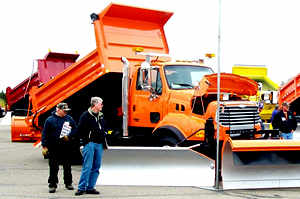 |
Participants at the fall Maintenance Expo looked over the equipment
display. Photos by Mike Travis
|
The 2002 fall Maintenance Expo was practically in Randy Reznicekís backyard.
Reznicek serves as maintenance superintendent at St. Cloud.
The expo was held Oct. 3-4 at the city of St. Cloudís Public Works Facility.
But the fall expo isnít about distance, itís about time: time to get ready,
to adjust attitudes and skills to meet the challenge of winter. Participants
will soon face winter skies and the steely onslaught of snow, ice, wind and
frigid temperatures.
Over 1,000 highway maintenance people per day sharpened their skills at the
snowplow roadeo, checked out advances in snow and ice control equipment and
practices and learned a thing or two about the ways crews from other districts,
cities, counties and townships gear up for the yearly contest with winter.
There was a lot to see and learn. Both the size of the outdoor equipment display
and the number of vendor booths inside increased from last year.
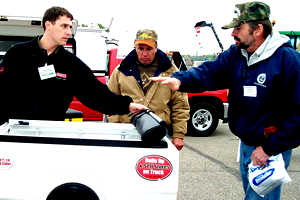 |
Brainerd's Brian Glenz (center) and Rick Pickard (right) talked to
a vendor.
|
Reznicek said 20 of his employees participated in the expo. He said they were
very interested in innovations such as a rear-mounted wing plow and advances
in anti-icing techniques.
"The people who are on our research and development committee were especially
interested in anti-icing because this winter we are going to be more serious
about using it through towns, on bridges and along tree lines," he said.
Crews from the St. Cloud maintenance area, he said, learned more about anti-icing
techniques, including temperature and moisture conditions when its use is most
effective.
The quick transfer of knowledge to practical use typifies the eventís usefulness
to participants.
"My guys who were there said the training break-out sessions were just
great," said Dave Redig, maintenance superintendent at Rochester.
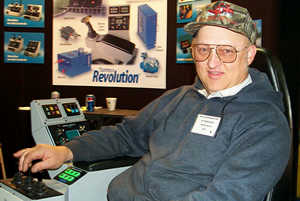 |
Duluth Metroís Ray Franckowiak tried out a three-way truck controller.
|
Redig said Rochester employees found heavy equipment training valuable as well
as learning about using water-filled crash barriers, seeing the motor graders
now made by Case and checking out new winter patching materials and equipment.
"We also got to see a new three-gang mower that we previously ordered
that was on display," Redig said.
Redig said some district employees purchased their own winter jackets with
regulation safety reflectors so they donít have to wear a more cumbersome combination
of jacket and vest.
"The expo gives us a great opportunity to exchange ideas with folks from
other districts, cities and counties," Redig said. "There is a lot
of interaction between people just standing in line for lunch, in the classroom
sessions and informal sessions at night," he added.
New, more advanced technologies also attracted interest.
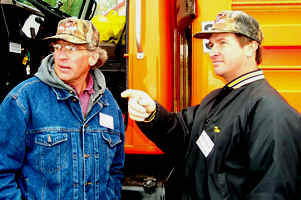 |
Mitch Berger, Little Falls transportation generalist, listened to last-minute
instructions from Douglas Countyís Tim Kalina before tackling the roadeo
course.
|
John Tarnowski, project manager, Maintenance Operations Research, said displays
such as the latest version of the tandem-axle test bed snowplow generated many
comments and questions.
"The test-bed tandem now has a rounded box to enable de-icing chemicals
to slide out more easily and to provide space for saddle-mount pre-wetting tanks,"
he said, adding, "It also has new, separate load-sensitive controllers
for the front and wing plows and the box to improve ease of control for operators."
Tarnkowski also noted the high degree of camaraderie evident among participants.
So did Marlene Horsman, a Rochester District permits technician who has served
on the eventís planning committee for 12 years.
"Attendance at the expo has tripled, party because the cities and counties
have piggy-backed with us to take part in it," she said. "Itís very
informative and a great learning experience. Once people get up there they really
enjoy it."
Horsman said one indicator of the expoís success is the growing number of vendors
who participate.
"We used to have to recruit vendors; this year we had more than last year
and many of them already signed up for next year so they can get the best locations,"
she said.
By Craig Wilkins
Rochesterís Bustad, Hammill take first, fifth spots in roadeo
Brian Bustad, transportation generalist, Austin Truck Station, earned
top scoring honors in the snowplow roadeo with 310 of possible 430 points.
Co-worker Jerry Hammill, a transportation generalist at Stewartville,
took fifth place with 290 total points.
The other finishers in the top five came from Ramsey County and the
cities of Oakdale and Eden Prairie.
Roadeo competition and other expo events garnered extensive news coverage,
especially from the electronic news media. TV stations from the Twin
Cities and Greater Minnesota covered the event as did the national Cable
News Network.
|
|
back

|
 |
State moves to automated hiring system on Nov. 2 |
 |
 |
Nov. 1 marks the last day Mn/DOT will use the traditional eligibility lists
to fill job vacancies within the state system. Instead, qualified candidates
will be chosen through the stateís new system, which bases selection on skills
and experience rather than test scores.
"This is a great opportunity for employees to identify and communicate
their knowledge, skills and abilities from past job experiences. A test doesnít
always show that, but a resume can," said Rich Peterson, assistant director,
Office of Human Resources.
The new system uses the Resumix software that requires employees to submit
a resume in order to be considered for other positions with Mn/DOT or other
state agencies. Employees may submit electronic versions of current resumes
or use the Resume Builder application on Mn/DOTís new Careers/Jobs Web site
at www.dot.state.mn.us/careers.html.
"This system offers significant benefits to current employees and will
help us to recruit job seekers outside of the state system. This is necessary
to continue to replace Mn/DOT ís workforce as our retirement and attrition numbers
grow," said Gary Simon, recruitment coordinator, Office of Human Resources.
"The new system features user-friendly tools
to view, apply and get notified about vacancies throughout the entire state
or within a small functional area. It really gives employees more flexibility
to manage their careers with the state," Simon added.
Resumes submitted to the new system remain active for one year. Employees choose
a password that allows them to update their resume any time their skills
or job information changes. Through this system, job seekers can apply directly
for state jobs, set-up "job search agents" to notify them about jobs
of interest and use other features to simplify their job search.
Resumes become inactive after one year in the system or if an employee is promoted
or hired for a new position. After the resume expires, employees must update
their skills and resubmit their resume. If the employee chooses not to resubmit
a resume, it will remain in the system under inactive status until the employee
logs on and resubmits it. At this point, employeesí resumes are reactivated
for another year.
Employees without convenient access to the Web also can submit their
resume by mail to the Department of Employee Relations, 658 Cedar Street,
2nd Floor, St. Paul, Minn. 55155-1603.
Contact your local Mn/DOT Human Resource office with any questions or comments.
By Daneeka Marshall-Oquendo
|
back

|
 |
Department renews diversity efforts |
 |
 |
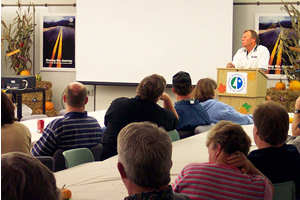 |
Tony Kempenich, district materials engineer and chair of the Brainerd
diversity committee, welcomes participants to the diversity celebration.
|
The departmentís first wave of diversity activities took place at Central Office
on Thursday, Oct. 3, initiating the departmentís renewed effort to integrate
diversity into its workplace and business practices.
Employees who attended the informational event heard from former Commissioner
Elwyn Tinklenberg and staff about the importance of diversity in the workplace
and the need to work more with a diverse population.
"Diversity in the workplace is a department priority because weíve learned
that we need to listen to our customers and recognize their needs; but more
importantly, weíve learned how we must be diverse in how we respond," said
acting Commissioner Doug Weiszhaar while delivering the departmentís diversity
initiatives.
Jim Swanson, director, Program Delivery Group, presented the Diversity Strategic
Plan that outlines the strategies and tactics Mn/DOT will use to diversify its
workforce.
"This plan will give us a strong foundation to build upon, and we now
have the necessary tools in place to help us move forward; itís time for action,"
said Swanson.
The event also featured the "Sharing the Journey" video and a skit
that dramatized the departmentís commitment to diversity.
"The diversity skit was a great way to confront the different attitudes
and behaviors most people have concerning diversity, the negatives as well as
the positives," said skit participant Gary Pettis, Communications and Public
Relations.
Several issues raised by audience members were addressed during the eventís
panel discussion, including a question about how the department plans to continue
these efforts with the next administration.
"A transition team has been formed to educate the new administration and
staff about the departmentís priorities and policies, diversity being one,"
said Dick Stehr, director of Program Support Group and panel member. "We
will actively work with them so they know the role they need to play to continue
this momentum."
Audience members were directed to the diversity
Web site where Mn/DOTís Management Team will address further questions or
comments about the departmentís diversity efforts.
By Daneeka Marshall-Oquendo
|
back

|
 |
Workshop training stresses security assessment techniques |
 |
 |
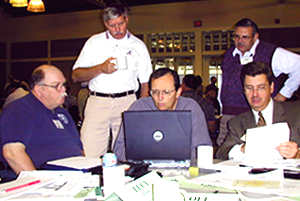 |
Work team members at the Vulnerability Assessment Workshop review their
progress in developing an assessment of key assets in the Twin Cities
metro area. From left: Bill Hughes, Ramsey County Emergency Services;
Joel Shilling, Minnesota Public Works Association; Phil Sauser, U.S.
Army Corps of Engineers; Jerry Liibbe, Federal Highway Administration;
and Greg Paulson, Rochester district engineer. Photo by Lucy Kender
|
The I-94 Dartmouth bridge in Minneapolis. The Duluth airport. The Mall of America.
The Metrodome. How would a terrorist view these highly visible assets? Are they
vulnerable to an attack?
How to make that determination was the topic of the Highway Vulnerability Assessment
Workshop, a training session held Sept. 30-Oct. 1. One hundred Mn/DOT, emergency
services, local community, law enforcement and military representatives joined
together to learn how to assess Mn/DOTís vulnerability.
The training, which was sponsored by Mn/DOTís Security Task Force, included
a scenario-based exercise which used a checklist of risk factors to determine
the vulnerability of several facilities in the Twin Cities and Duluth metro
areas.
"I think this training was important to emphasize to Mn/DOT staff that
weíre part of a statewide perspective. We need to work with other groups to
ensure our mission gets done," said Cathy Clark, acting administrative
manager, Brainerd/District 3.
Mn/DOTís workshop participants will now begin the process of completing "real-life"
vulnerability assessments in their home districts.
"Our goal is to complete district assessments and develop action plans
by March 2003," said Mike Sobolewski, Mn/DOTís transportation security
analyst. "We will ask districts to put together teams in their local areas
that are similar to the mix of people at the workshop in order to ensure that
we get a good regional perspective of risks and resources."
Working with local partners is really key to the success of this process, according
to Jim Swanson, director, Program Delivery Group.
"Weíre all in this together. The public expects us to make our transportation
system safe," said Swanson.
"It was a good exercise to rate special hazards and risk situations,"
said Bill Hughes, operations and planning officer for Ramsey County Emergency
Services, adding: "I plan to bring this back to my office and use it as
a tool. Itís important to have a way to determine where money should be spent
first, especially when dealing with infrastructure."
The vulnerability assessment training, facilitated by the Science Applications
International Corporation, is the first step for Mn/DOTís overall security plan,
Sobolewski said.
"We also hope to sponsor a disaster response exercise this winter and
weíre continuing to update Mn/DOTís emergency response and disaster recovery
plans," he said.
"SAIC, under the auspices of AASHTO, will conduct this training in other
states as well," Sobolewski said. "We hope to learn from other DOTsí
experience with this process and continue to refine it."
By Lucy Kender
|
back

|
 |
Tinklenberg debates Taxpayers League's David Strom |
 |
 |
In a sometimes heated exchange, former Transportation Commissioner Elwyn Tinklenberg
today took on David Strom, Minnesota Taxpayers League, at an event sponsored
by the Minnesota Transportation Alliance.
In addition to advocating for a statewide, multi-modal, long-term funding plan,
Tinklenberg spent much of the debate correcting Strom's "loose" use of facts
and figures.
For example, Strom argued that his group supports using revenue generated from
the Motor Vehicle Sales Tax for roads and bridges. However, when talking about
the total dollars that would mean for roads, Strom did not subtract the $132
million of the fund that is currently allocated for transit operating costs.
This money was put in place to restore funding eliminated through property tax
reform.
Strom also said that his group favors investing in projects based on a cost-benefit
analysis and that transit projects do not meet that standard. Tinklenberg countered
that there are numerous roads in the state that are critical to economic growth
that wouldn't meet this standard either.
He went on to warn audience members representing Greater Minnesota that under
the Taxpayer League's strategy, rural Minnesota would be left out in the cold.
Mn/DOT recently issued a news release including facts about transportation
needs and funding. For a copy, go to http://www.dot.state.mn.us/information/funding2002/fundingfacts.html.
By Shannon Beaudin Klein
|
back

|
 |
Mn/DOT, DPS join national effort to achieve zero traffic deaths |
 |
 |
 |
Mn/DOT and the Department of Public Safety will join a national effort
on Oct. 10, Put the Brakes on Fatalities Day, to achieve one
full day of no traffic deaths. In Minnesota, an average of 625 people
die in crashes every year.
|
Mn/DOT and the Department of Public Safety will join a national effort on Oct.
10, Put the Brakes on Fatalities Day, to achieve one full day of no traffic
deaths by encouraging safer behavior and promoting safer roadways.
"In Minnesota, an average of 625 people die in crashes every year. Most
of these crashes are the result of human error," said Kathy Swanson, director
of traffic safety with DPS. "By working together, we can reduce the number
of deaths."
Mn/DOTís highway safety program includes improved lighting which can reduce
night crashes by 50 percent, upgrading two-lane highways to four lanes in rural
areas where 75 percent of fatal crashes occur and widening paved shoulders by
six to eight feet that can reduce crashes by as much as 40 percent, said Gary
Thompson, state traffic engineer.
The observance also promotes safer driving practices. For example, increasing
seat belt use from the current 74 percent to 85 percent would save more than
100 lives each year. Reducing legal blood alcohol level from 0.10 percent to
0.08 percent would also save 50 lives each year, Swanson said.
Officials chose October for the Put the Brakes on Fatalities Day observance
because it ranks among the peak months for traffic deaths.
Mn/DOT and DPS created an initiative known as Toward Zero Deaths to
work with communities statewide on traffic safety improvement. The four primary
components of the initiative are education, engineering, enforcement and emergency
response.
For traffic safety tips or other information on the dayís observance, see the
Web site, www.brakesonfatalities.org.
By Sonia Pitt
|
back

|
 |
Ceremony transfers ownership of Hiawatha LRT facility to Met Council |
 |
 |
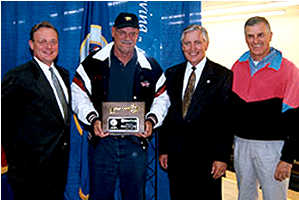 |
Mn/DOT turned the Hiawatha LRT Operations Facility's keys over to the
Metropolitan Council Oct. 4. Participants included (from left): Met
Council Chair Ted Mondale, Gov. Jesse Ventura, former Mn/DOT Commissioner
Elwyn Tinklenberg and Hennepin County Commissioner Peter McLaughlin.
Photo by Kevin Gutknecht
|
Former Commissioner Elwyn Tinklenberg officially turned over the keys to the
Light Rail Transit Operations Facility to the Metropolitan Council on Oct. 4.
While mainly symbolic, the transfer marked the progress on construction of the
Hiawatha Light Rail line. About 55 percent of the construction work is now done.
After Mn/DOT finishes construction, Metro Transit will operate the new light
rail commuter system. The Metropolitan Council will own the line.
The ceremony took place at the systemís maintenance and storage building near
Cedar Avenue in Minneapolis. Participants included Tinklenberg, Met Council
Chair Ted Mondale, Hennepin County Commissioner Peter McLaughlin, Gov. Jesse
Ventura and staff from the Hiawatha Project Office, Mn/DOT and the Metropolitan
Council.
Work on the light rail line continued during the ceremony. Crews continued
to install rail in downtown Minneapolis and elsewhere on the 11.6-mile route,
work on stations along the route and dig tunnels at the Minneapolis-St. Paul
International Airport. The twin tunnels will take the line underneath airport
runways to connect with two stations that will serve airport patrons.
Service will begin in the spring of 2004 on the first section of the line,
which runs from the Warehouse District in downtown Minneapolis to Fort Snelling.
Service to the airport and the Mall of America in Bloomington will begin in
December 2004.
By Craig Wilkins
|
back

|
 |
Freese appointed South Metro area manager in Metro Division |
 |
 |
Lisa Freese was appointed as the South Metro area manager for the Metro Division.
She succeeds Lezlie Vermillion, who was named Scott County engineer.
Freese started working at Mn/DOT in 1999 and has two years' experience in the
Access Management and Land Use section of the Office of Investment Management.
She also has 18 months of experience in the Planning & Investment Management
Office at Metro.
Before joining Mn/DOT, Freese worked at Minnesota Planning for two years where
she established the Local Planning Assistance Center and provided technical
assistance for a local government planning grant program.
She also brings 15 years of expertise as a local government planner, and has
also worked for several city and county governments in the Kansas City and Twin
Cities metropolitan areas.
Freese holds a masterís degree in urban and regional planning from the University
of Iowa. She is a member of the American Institute of Certified Planners and
an executive board member of the Minnesota Chapter of the American Planning
Association.
|
back

|
 |
Morris Maintenance Area, Appleton move into shared maintenance facility |
 |
 |
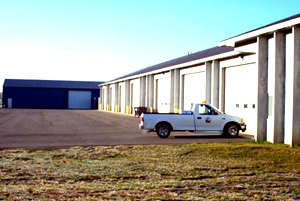 |
City and Mn/DOT officials opened a new shared maintenance facility
at Appleton on Sept. 26. Photo by Dean Olson
|
A new maintenance facility at Appleton built by the city of Appleton and Detroit
Lakes/District 4 joins the trend whereby Mn/DOT, cities and counties share buildings,
sand and salt sheds and other support structures in order to cut costs and gain
operating efficiencies.
City and Mn/DOT officials opened the new facility at Appleton on Sept. 26.
The new building cost approximately $1 million, with Mn/DOT paying about one-fourth
of the total price.
The building contains 13,220 square feet and now houses the two-person Appleton
Truck Station crew and its equipment, city crews and administrative offices.
It also includes a large vehicle storage area.
Jerry Miller, District 4 ADE for operations at Morris, said the building uses
geothermal heat, which is economical and provides heated floors that improve
working conditions and help dry snowplows wet with snow and ice. The Mn/DOT
crew previously occupied a 1930s era building in poor condition.
Miller said sharing the new facility will help the crew to improve service
in the growing region of Swift County.
By Craig Wilkins
|
back

|
 |
|
 |



